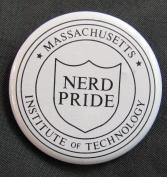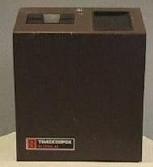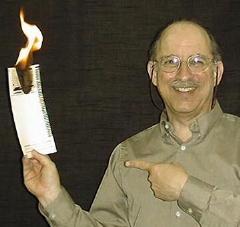 This entry contains the first half of an after-dinner speech which I presented at the Kronos World Wide Sales and Service Conference in Chicago, on Friday, May 30, 1997. There were about 800 Kronos personnel in the audience. My image was projected on two 4.25 meter high screens (14 feet), so that people in the back of the room could see me. Written to suit the occasion, this speech contains a good deal more humor than my usual memoirs entry. I've added the photographs; they were not shown at the time of the speech. I've also added footnotes, to clarify items that might not be clear to a non-Kronos audience or due to the passage of time. Given the length of the speech (about 5,300 words, which took about 45 minutes), I've broken it up into two entries. This is part 1 of 2. I guess they decided that you haven't heard enough speakers today. After all the sessions you've been through, I'm sure that right now, everyone is thinking, "Oh, good, a short speaker!" I tower over Keith Gattozzi, though. See, if you dare leave Kronos, we make fun of you. I like these video screens, though; I'm 14 feet tall from the waist up. Kind of makes me want to take up basketball. I'm just delighted to get an all-expense paid trip to Chicago. They don't let me out much, they keep me locked up with my computer, and throw Chinese food and cans of Coke through the bars. I keep hitting the ESCAPE key, but I'm still there. While I'm in Chicago, I can also visit my daughter, who's a freshman at Northwestern. Lots of her friends are theater majors. A few weeks ago, I had just finished watching the TV show Ellen, when my daughter phoned, and told me she is now a thespian. I said, hey, whatever works for you is all right with me. It turned out she'd gotten a role in a play. She's here tonight, but by the end of this speech, she may be pretending not to know me. Note 1
But the computer revolution has changed things. Now, when they find out I'm a computer expert, women come over to me and say, "Hey, big boy, how'd you like to come up to my room and configure my modem". Nowadays our best pickup lines start with "ATDT ..." I see only the service people got that one. Note 3 Of course, when I do get up to their rooms, it turns out that they really do just want me to configure their modems. I'm just kidding about all this, you know; actually, I've been happily married for 27 years. But I digress. You'll find I digress a lot. What I'd really like to talk about tonight is Kronos history. After all, as the old Spanish saying goes, I'm sure you all know it, Si uno trabaja para Kronos, uno es un cronista. That is, if one works for Kronos, one is a cronista, a chronicler. Kronos, after all, was the Greek God of Time. The Roman version of his name, spelled with a "CH", is the root of words like "Chronometer." That's why our Vice President of MIS is named "Thor" Note 4 - I am not making this up! Anyway, tonight, my job, should I choose to accept it, Note 5 is to cover the history of Time Accounting, from those prehistoric clock watchers, who watched the sun to know when they could drop their spears, and go knock down some brewskis, up to that Titanic Tower of Timekeeping Technology, TKC. Note 6 Not that this is necessarily progress. Kronos was not always the industry leader it is today, fabled in story and song, and written up in Fortune, Forbes, and The North-west Wyoming Retail Grocer. No, twenty years ago, Kronos comprised three people, Note 7 crowded around founder Mark Ain's kitchen table, reviewing a list of company startup criteria written on a single 8½ by 11 sheet of paper. The product they ultimately settled on, the electronic timeclock, sprung out of Mark's observation that all phases of the payroll process had been automated except the timeclock, and due to the incredible reduction in the price of computing power brought on by the microprocessor, putting a complete computer into a timeclock had become possible. As Robert X. Cringely noted, "if the automobile had followed the same development cycle as the computer, a Rolls-Royce would today cost $100, and get a million miles per gallon. Of course, it would also explode once a year, killing everyone inside." The founders developed the initial clock, hardware and software, which took a couple of years. It was then that I came to be interviewed at Kronos. That was 18 years ago, back when I had hair, and I was tall. I walked up to Kronos's offices on the third floor at 355 Western Avenue, over the Auciello Iron Works. The offices were extremely grungy and dilapidated. The carpet was so dirty that it was impossible to tell its original color. As I walked in, I tripped on a loop of fibers sticking up from a long rip in the carpet. But in a startup company, I took all this as a good sign. Startups that spend too much money tend to fail early. Larry Baxter, one of the original founders, interviewed me over dinner. He fed me a pre-dinner drink, lots of wine, and an after-dinner brandy. I later discovered that one of the organizing principles of Larry's life is to do as much of his eating and drinking as possible on pre-tax dollars. He also likes to eat at restaurants where, if you tell them someone in your party is having a birthday, they bring you free cake. But I digress. We then returned to the Kronos offices for, I assumed, a brief windup. Instead, Larry placed three sheets of paper on the table, with a really tough technical problem written on them. Well, actually it was only one sheet of paper, but I was so sloshed that it looked like three to me. Besides, the table was clearly rotating. Now, Larry Baxter, like me, is an Electrical Engineer. I don't mean we're engineers who run on electricity, I mean that we have degrees in Electrical Engineering. Anyway, there's a concept in Electrical Engineering called "Marginal Testing", in which you test the robustness of a circuit by over-stressing it. For example, you crank up the clock speed on a microprocessor until it fails. Using alcohol, I was being subjected to Marginal Testing. I must have done reasonably well, because Kronos offered me the job of Chief Engineer. While thinking over their offer, I telephoned Bob Cohen of Interboro Time Clock, as it was called back then, to find out how actual timeclock salespeople were reacting to the clock. Interboro has been Kronos' partner since the clock was first conceived; Bob is one of the inventors named on the original Kronos patent. When I called Bob, I interrupted a meeting he was having to describe the clock to his staff, and he told me of their excitement, using colorful and vivid language not suitable for this gathering, but which I remember still.
Let's see if this old prototype can still punch a card. [Speaker prepares to stick a card into the clock] By the way, you wouldn't believe what it took me to get this thing through airport security. They thought it was an FAA test bomb. Back then, this unit was just called "The Clock", rather than a "System 40" or "System 70", because there only was one kind. Note the old mark-sense TK-572 cards, with the tear-off tabs used for card preparation [Rips off tab].
Cool, it still works! That's just what it did back then! Ship it! A standard high-quality Kronos design. I don't know what the investors were so worked up about. OK, it had a minor problem. Every now and then, completely unpredictably, when you stuck in a card, it would energize the card clamp solenoid, and then go out to lunch. After some time, the solenoid would begin to smoke, not to mention the fact that you couldn't get your card back. Nobody knew why this happened. Eighteen years ago, when I started at Kronos, I wouldn't have recommended a Kronos timeclock to my worst enemy. Today, I'd recommend one to my worst enemy without hesitation. Just kidding. Well, I was told to sit down and get to the root of the problem, because you can't get to the root of a problem like that while standing up. The hardware designers said it was the software, and the software designers said it was the hardware. Du-u-uh! Look how we've grown! Now when we want to blame Engineering, we have [gesturing across room] an entire sales department to do it! Anyway, I had a background in both hardware and software, and in a few weeks, I traced the problem to the software, to a very badly designed interrupt system, thereby saving Kronos' corporate ass, if corporations can be said to have an ass. Programmers in the audience, aren't you jealous? Has your code ever actually caused a product to catch fire? It was like an old joke come true, the famous "HCF" computer instruction, meaning "Halt and Catch Fire". Kronos had actually implemented it! It would have been safer if Microsoft had written the clock software. Then we would have only needed one indicator on the front panel, reading "General Protection Fault", and a large button labeled "Control-Alt-Delete". Note 9 But Microsoft didn't even exist in those days, and who the hell would have thought that users would let you get away with that? Boy, I'll tell you, computers let you make more mistakes, and faster, than anything except handguns and tequila. Note 10 We had to almost completely re-write the clock software. It was tough going for a while, with long hours. I lost some hair, and got beaten down a bit. I'm no longer tall, dark, and handsome (but two out of three isn't bad). After the re-write, the lockup problem disappeared completely. I could finally look at it, and say, "Now that's a crock - Uh, clock - that we can ship." And the initial customers loved it. A customer said the clock added up the cards more accurately than he could. I said, "Yeah, I can't add very well either." Around that time, I received a letter addressed to "Mr. Krakauer, Dronos" That's D as in Dog, R, O, N, O, S. I kind of liked it, because it sounded like a good name for a "Kronos Drone," so I hung it on the wall, labeled "Best Misspelling Contest." People started adding others. Over the last eighteen years, I've actually collected 241 different misspellings of the simple six-letter name "Kronos". Just before coming out here, I posted the list to the KRONOS Sales and Service Bulletin board. Take a look at it. It also explains how to send in a new misspelling, and get a handsome certificate, suitable for framing. [Holds up misspelling certificate] Note 11   Note 1: This reference was topical: a month before the speech, on April 30, 1997, the comedienne Ellen DeGeneres had "come out of the closet" as a lesbian on her TV show. [return to text] Note 2: I wonder if this reference might be lost on a modern audience. The schools of my youth made much use of reel-to-reel motion picture projectors, and often the more technically oriented students assisted in running them, which involved setting them up, threading the film, rewinding the film after the show, and so on. I'm not sure that things have gotten much better in these days of PowerPoint presentations, laptop computers and LCD projectors. I was once at an Engineering Department meeting that was canceled thirty minutes after starting, because nobody among the 30 or so engineers in attendance could get the laptop computer to play with the LCD projector. [return to text] Note 3: Modems (it stands for "Modulator - Demodulator") convert data into audible tones, and back, for transmission over telephone lines. They are controlled by character sequences called, not surprisingly, "control strings". Many of these started with the characters "ATDT ...". That stood for "Attention" (string of control characters to follow), "Dial Tone" (take the phone "off-hook" to prepare to dial a phone number, await a dial tone, and then continue processing the control string). All Kronos service personnel were intimately familiar with these modem control strings, so they all got the joke. [return to text] Note 4: "MIS" stood for "Management Information Systems", which is what many companies called their in-house computer department. The director of that department at Kronos at the time was named Thor Wallace. [return to text] Note 5: The line "should I choose to accept it" was a reference to the TV show "Mission: Impossible", which started with an "impossible" mission being described to the team. This always began with "Your mission, should you choose to accept it ...". [return to text] Note 6: TKC was Kronos's main software product at the time. The abbreviation stood for "TimeKeeper Central". Did you ever notice that "bookkeeper" is the only English word with three double letters in a row? [return to text] Note 7: I took this opportunity to put in a plug for the proper use of "comprise". The common usage "is comprised of" is not correct. The whole point of "comprise" is to replace "is composed of" with a single word. [return to text] Note 8: "Mark" was Mark Ain, the president and one of the founders of Kronos. Looking for a signature color for the Kronos timeclocks, he indeed selected an orange color similar to that of his BMW. Kronos timeclocks were all orange for many years, until the Marketing Department finally prevailed on him to allow other colors. [return to text] Note 9: In the early days of the Microsoft Windows operating system, computers would often die after displaying the dreaded message "General Protection Fault". This led to various jokes. In one, it was said that Microsoft was getting into the business of manufacturing condoms, which would give a new meaning to the term "General Protection Fault". The first thing to try in Windows when faced with a crash would be the sequence "Control-Alt-Delete" - that is, simultaneously hold down the Control, Alt, and Delete keys. This would restart your system. Actually, it's still used - it now first brings up the Windows Task Manager, but if you hit it twice, it does a restart. [return to text] Note 10: The quote about handguns and tequila came from Mitch Radcliffe. [return to text] Note 11: Click here to see the whole Kronos misspelling list. [return to text]  |

 Amazingly, we found one of the old prototype clocks in a closet.
Amazingly, we found one of the old prototype clocks in a closet.  [Demo: Speaker sticks the timecard into the clock. There is a loud clock clamp "thunk" sound. The clock buzzes; the speaker pretends to try to yank the card out of the clock, unsuccessfully. Finally, the card is pulled out, in flames. Speaker stares at the burning card in feigned astonishment, then douses it in the pitcher of water at the podium.]
[Demo: Speaker sticks the timecard into the clock. There is a loud clock clamp "thunk" sound. The clock buzzes; the speaker pretends to try to yank the card out of the clock, unsuccessfully. Finally, the card is pulled out, in flames. Speaker stares at the burning card in feigned astonishment, then douses it in the pitcher of water at the podium.]